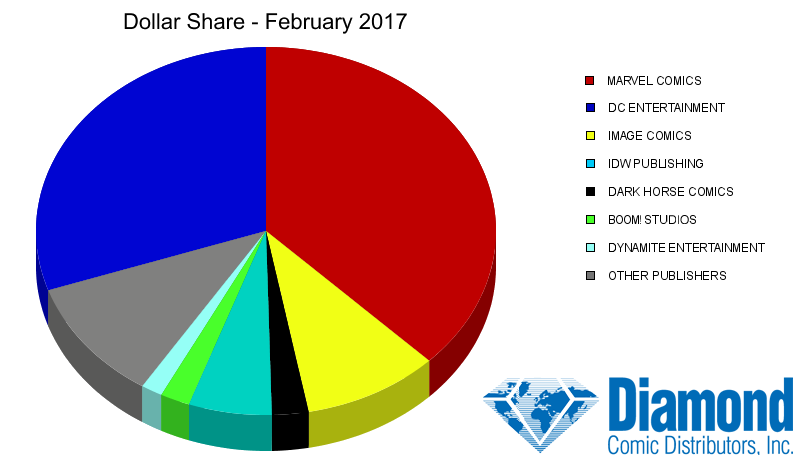While the House of Ideas may have scored the top-selling comic book for February 2017 with Star Wars: Darth Maul #1 — not counting the 25¢ issue of The Walking Dead — DC claimed seven of the Top 10 sales spots, achieving near parity with Marvel in unit sales.
According to John Jackson Miller, longtime editor of the much-missed Comics Buyers’ Guide, who keeps track of such things, February saw more total comic books (7.85 million) ship to North American comics specialty shops than in any February since 1997. Of course, much of that was on the back of The Walking Dead #163. Although JJM’s estimated sales report for February us not out yet, the initial estimate on the quarter comics is 750,000 copies sold to retailers.
[Aside: For those not in the know, JJM and the website ICv2.com team on monthly comic book sales estimates, using known actual sales from sources within the industry to extrapolate on the index rankings published by Diamond Distribution. The estimate is for sales by Diamond to stores (not necessarily to fans) in North America. While limited, the estimates are thought to represent about 85-90% or total sales. The industry-wide numbers, such as the ones discussed in this article, come direct from Diamond, however.]
Setting aside TWD #163, the Top 10 regular comics books for February 2017 looks like this:
1. STAR WARS: DARTH MAUL #1 (Marvel)
2. BATMAN #16 (DC)
3. BATMAN #17 (DC)
4. JUSTICE LEAGUE OF AMERICA #1 (DC)
5. SUPER SONS #1 (DC)
6. THE WALKING DEAD #164 (Image)
7. ALL-STAR BATMAN #7 (DC)
8. STAR WARS #28 (Marvel)
9. JUSTICE LEAGUE OF AMERICA: REBIRTH #1 (DC)
10. JUSTICE LEAGUE #14 (DC)
But what may be even more notable than DC’s dominance of the Top 10 is its overall sales. Despite releasing fewer regular comic books than Marvel in February (82 vs. 104), as well as fewer book-sized items (33 vs. 36), DC managed to rack up 33.47 percent of the overall unit sales for the month. Marvel, meanwhile, only managed 33.63 percent. Image placed a distant 3rd at 18.12 percent, followed by IDW, at 3.27 percent, and Dark Horse, at 1.45 percent.
Miller says DC’s strong showing can be traced to it “holding the line at $2.99,” writing:
” . . . you can easily see from the dollar market shares the impact of the $3.99/$2.99 contrast between Marvel and DC’s cover prices. Marvel’s dollar market share is nearly four points higher than its unit share; DC’s more than three points lower.”
Over on The Comics Beat, site owner Heidi MacDonald sees a grim portent in the numbers for Marvel, writing:
“It’s the clearest sign yet that Marvel’s sales have slipped badly and DC is happy to step in where they can. Last month Marvel led DC by 9 points in dollars and 11 points in units – but January also saw a huge free overshipping program from Marvel…probably to avoid this very thing.”
Of course, dollars are what publishers and retailers alike count, not numbers of product sold, and as JJM notes, DC still trails Marvel there, having taken in 30.23 percent of the $39.77 million in comics, graphic novels and magazines moved by Diamond in February, compared to 37.46 percent for Marvel.
JJM also points out that, despite the high number of books sent to comic books stores in February, the dollar tally is the first sub-$40 million total for a February in three years. Compared to February 2016, total dollar sales for regular comics books was down 4.47 percent, even as unit sales were up 17.29 percent.
So, far, 2017 is off to a rough start for the comics industry, as noted by Milton Griepp, of ICv2.com:
This [February] was similar to the 3.41 percent decline reported for January, bringing the year-to-date number to a 3.76 percent decline vs. the first two months of 2016.
As most DC Comics fans know by now, DC will mark up the cover price of its monthly books to the Marvel $3.99 standard starting in April, leaving only its bi-weekly books at the current $2.99. That may help DC close the gap on Marvel in terms of dollar share, but will it hurt overall sales. The discussion topic for the comments section below: If DC makes more money, but sells fewer actual comic books, is that, overall, a good or a bad thing for the long-term health of the industry?

